Anthropology > QUESTIONS & ANSWERS > Of Ice and Mud: From Africa to the World, From Foraging to Farming Multiple Choice Questions AND ANS (All)
Of Ice and Mud: From Africa to the World, From Foraging to Farming Multiple Choice Questions AND ANSWERS
Document Content and Description Below
Chapter 1 Of Ice and Mud: From Africa to the World, From Foraging to Farming Multiple Choice Questions AND ANSWERS 1. Homo erectus lived approximately a. 4.5 million years ago. b. 2.5 million... years ago. c. 1.5 million years ago. d. 30,000 years ago. Learning Objective: L.O.1.1: What changes resulted from early human migration? Topic/Concept: The Beginnings Of Divergence: Migration Difficulty Level: Easy Skill Level: Remember the Facts 2. People migrated from Africa to which TWO areas first? a. Australia and the Americas b. Europe and the Middle East c. The Middle East and China d. Australia and China Learning Objective: L.O.1.1: What changes resulted from early human migration? Topic/Concept: The Beginnings Of Divergence: Migration Difficulty Level: Easy Skill Level: Remember the Facts 3. The significance of Zhoukhoudian Cave is a. that it provides early evidence for the use of fire. b. that it provides evidence that Neanderthals and humans interbred. c. that it is the earliest site in the New World inhabited by humans. d. that it provides the earliest evidence for human burial ritual. Learning Objective: L.O.1.1: What changes resulted from early human migration? Topic/Concept: The Beginnings Of Divergence: Migration Difficulty Level: Easy Skill Level: Remember the Facts 4. In foraging societies, it is common for a. members of both sexes to share equally in hunting and gathering. b. men to be the primary foragers. c. women to be the hunters and men to be the gatherers. d. men to be the hunters and women to be the gatherers. Learning Objective: L.O.1.1: What changes resulted from early human migration? Topic/Concept: The Beginnings Of Divergence: Migration Difficulty Level: Moderate Skill Level: Understand the Concepts 5. During the Ice Age, cave art was used a. in very different ways in different places. b. only for ritual purposes. c. in very similar ways in different places. d. only for hunting rituals and purposes. Learning Objective: L.O.1.1: What changes resulted from early human migration? Topic/Concept: The Beginnings Of Divergence: Migration Difficulty Level: Moderate Skill Level: Understand the Concepts 6. The role of feasts in the Ice Age is believed to have functioned primarily a. to celebrate weddings. b. to occur only after serious conflicts were ended. c. to strengthen group ties. d. to occur only when food was abundant. Learning Objective: L.O.1.1: What changes resulted from early human migration? Topic/Concept: The Beginnings Of Divergence: Migration Difficulty Level: Moderate Skill Level: Understand the Concepts 7. Which of the following occurred 18,000 and 15,000 years ago and affected early foraging communities? a. several ecological disasters that made major changes to the world landscape b. enormous regional fluctuations in temperature c. separation of land masses that disrupted migration patterns d. a widespread disease that killed off a large segment of the population Learning Objective: L.O.1.2: How did human life change when the Ice Age ended? Topic/Concept: The Acceleration of Divergence: Different Foraging Cultures Difficulty Level: Moderate Skill Level: Understand the Concepts 8. Which of the following was considered to be an important part of early societies where hunting prowess and skill in war determined status? a. handmade weapons b. dogs c. large stature and good health d. the amount of fur and pelt clothing an individual possessed Learning Objective: L.O.1.2: How did human life change when the Ice Age ended? Topic/Concept: The Acceleration of Divergence: Different Foraging Cultures Difficulty Level: Moderate Skill Level: Understand the Concepts 9. Why were post-Ice Age Middle East settlers able to remain in one place without the development of agriculture? a. They were able to forage and stockpile nuts and seeds and had herds of gazelles to help meet their additional nutritional needs. b. They lived on prairies that held inexhaustible stocks of bison. c. They harpooned seals, stuck pigs, and drove deer into pits or ponds. d. They lived in an environment filled with tundra-loving red deer, elk, and wild boar in wooded surroundings. Learning Objective: L.O.1.2: How did human life change when the Ice Age ended? Topic/Concept: The Acceleration of Divergence: Different Foraging Cultures Difficulty Level: Moderate Skill Level: Understand the Concepts 10. Why were settled foragers better off than early farmers? a. They were not affected by climate and weather. b. They had a stronger sense of community. c. They had better health and nourishment. d. They did not have to fight for their territory. Learning Objective: L.O.1.2: How did human life change when the Ice Age ended? Topic/Concept: The Acceleration of Divergence: Different Foraging Cultures Difficulty Level: Moderate Skill Level: Understand the Concepts 11. Which of the following settlements shows evidence of settled life from about 10,000 years ago in the Egyptian Sahara and fostered about forty plant species, which grew alongside hearths and pit ovens? a. the Jomon people b. Nabta Playa c. Göbekli Tepe d. Natuf Learning Objective: L.O.1.2: How did human life change when the Ice Age ended? Topic/Concept: The Acceleration of Divergence: Different Foraging Cultures Difficulty Level: Easy Skill Level: Remember the Facts 12. Which of the following suggests that early settlements were made up of families? a. Archeologists have found remains in communal graves of women and children. b. Cave art suggests that lives centered around family events. c. There is evidence of small, permanent houses as well as communal work areas. d. Evidence exists of inherited physical characteristics. Learning Objective: L.O.1.2: How did human life change when the Ice Age ended? Topic/Concept: The Acceleration of Divergence: Different Foraging Cultures Difficulty Level: Moderate Skill Level: Understand the Concepts 13. Why was the early development from foraging to farming unreliable? a. Early peoples did not have the knowledge or technology to cultivate crops. b. By relying on a relatively small range of farmed foods they were vulnerable to ecological disasters and famine. c. Individuals tried to work the land but could not convince the entire community to engage in order to make farming successful. d. They food that could easily be grown was not readily accepted as edible by cultures used to eating foraged products. Learning Objective: L.O.1.3: What kinds of environments were suited to the development of herding and of tilling respectively? Topic/Concept: The Beginnings of Farming Difficulty Level: Moderate Skill Level: Understand the Concepts 14. Which of the following environments is suitable for tillage? a. one where plants are too sparse or indigestible to sustain human life, but animals can convert these plants into meat b. one where the soil is suitable or enough ecological diversity exists to sustain it or to support mixed farming of plants and animals c. one where average temperatures are low and the growing season is too short d. the tundra and the evergreen forests of northern Eurasia Learning Objective: L.O.1.3: What kinds of environments were suited to the development of herding and of tilling respectively? Topic/Concept: The Beginnings of Farming Difficulty Level: Moderate Skill Level: Understand the Concepts 15. Why did herders that dealt with milk-yielding stock like cattle, sheep, horses, and goats require a modification of human evolution? a. Most people were not able to digest lactase, which helps people digest milk. b. Their normal tendency was to kill prey rather than foster its growth. c. From their earlier beginnings, herders had initially worshipped these animals as gods. d. These animals were always considered to be inedible by early settlers. Learning Objective: L.O.1.3: What kinds of environments were suited to the development of herding and of tilling respectively? Topic/Concept: The Beginnings of Farming Difficulty Level: Moderate Skill Level: Understand the Concepts 16. Why was a dibble important to early tillage societies? a. It helped measure how much rainfall a certain region had in order to determine its suitability for planting. b. It was used as a tool to harvest crops such as rice or millet. c. It was the only technology available to dig holes in the ground for planting. d. It measured the height of crops to determine if they were ready for harvesting. Learning Objective: L.O.1.3: What kinds of environments were suited to the development of herding and of tilling respectively? Topic/Concept: The Beginnings of Farming Difficulty Level: Moderate Skill Level: Understand the Concepts 17. What did swampland cultivators do to adapt the land for planting when rice was unavailable for cultivation? a. In suitable conditions they dredged the earth by hand and built up mounds for planting. b. They created a drainage system that uncovered drier planting areas. c. They used rocks and fillers to create dams that kept water out of agricultural zones. d. They claimed more territory outside the swamplands to cultivate. Learning Objective: L.O.1.3: What kinds of environments were suited to the development of herding and of tilling respectively? Topic/Concept: The Beginnings of Farming Difficulty Level: Moderate Skill Level: Understand the Concepts 18. Why were potatoes grown at high altitudes better for consumption than those grown at lower altitudes? a. Potatoes grown at lower altitude take processing to become edible, but the concentration of poison in potatoes diminishes the higher they are grown. b. They have a higher concentration of vitamins and nutrients at higher elevations. c. The high-altitude soils give the potato a better taste when prepared for food. d. The high-altitude makes the potato grow faster and bigger. Learning Objective: L.O.1.3: What kinds of environments were suited to the development of herding and of tilling respectively? Topic/Concept: The Beginnings of Farming Difficulty Level: Moderate Skill Level: Understand the Concepts 19. Which of the following regions was the most conducive to the production of wheat and barley? a. central Eurasia b. the Andean region c. Mesoamerica d. the Middle East Learning Objective: L.O.1.4: What are some examples of the early spread of agriculture? Topic/Concept: The Spread of Agriculture Difficulty Level: Easy Skill Level: Remember the Facts 20. Which of the following drove southwest Asian migrants with their farming materials and knowledge to Europe? a. widespread famine b. civil unrest and the territorial expansion of their enemies c. arboreal diseases drove forests into retreat d. several seasons of drought caused desert conditions to encroach on their settlements Learning Objective: L.O.1.4: What are some examples of the early spread of agriculture? Topic/Concept: The Spread of Agriculture Difficulty Level: Easy Skill Level: Remember the Facts 21. Which of the following first made its appearance in India about 7,500 years ago? a. llamas b. cotton thread c. sweet potato d. maize Learning Objective: L.O.1.4: What are some examples of the early spread of agriculture? Topic/Concept: The Spread of Agriculture Difficulty Level: Easy Skill Level: Remember the Facts 22. When did maize begin to be cultivated in the United States? a. 2,000 years ago b. 3,000 years ago c. 4,000 years ago d. 5,000 years ago Learning Objective: L.O.1.4: What are some examples of the early spread of agriculture? Topic/Concept: The Spread of Agriculture Difficulty Level: Easy Skill Level: Remember the Facts 23. How did early agricultural development spread in Africa? a. migration b. there was no intermediate phase between foraging and farming c. one region influenced other regions d. new varieties of crops developed as they crossed climate zones Learning Objective: L.O.1.4: What are some examples of the early spread of agriculture? Topic/Concept: The Spread of Agriculture Difficulty Level: Moderate Skill Level: Understand the Concepts 24. Which of the following theories is most accepted as to how agriculture grew in the Pacific Islands? a. Natural disasters caused destruction to the available foraging materials. b. It spread along the region with the Bantu language. c. It diffused from New Guinea and spread with seaborne migrants. d. There was no intermediate phase between foraging and farming. Learning Objective: L.O.1.4: What are some examples of the early spread of agriculture? Topic/Concept: The Spread of Agriculture Difficulty Level: Moderate Skill Level: Understand the Concepts 25. Which of the following accurately describes the relationship between population growth and agriculture? a. Population growth was a consequence of agriculture. b. Population growth was the cause of the development of agriculture. c. Population growth and the growth of agriculture have no relationship. d. Population growth negatively affects the growth of agriculture. Learning Objective: L.O.1.5: How might farming have started? Topic/Concept: So Why Did Farming Start? Difficulty Level: Moderate Skill Level: Understand the Concepts 26. Which of the following theories describing the reason for the development of agriculture is supported by successful fishermen in Southeast Asia who devoted their spare time to experimenting with plants? a. stress theory b. abundance theory c. religious influences d. political influences Learning Objective: L.O.1.5: How might farming have started? Topic/Concept: So Why Did Farming Start? Difficulty Level: Moderate Skill Level: Understand the Concepts 27. Which of the following was considered an inspiration for farming as a method of fertility rites and special recognition of certain plants? a. abundance b. religion c. climate changes d. migration Learning Objective: L.O.1.5: How might farming have started? Topic/Concept: So Why Did Farming Start? Difficulty Level: Easy Skill Level: Remember the Facts 28. How did early farmers react to the cooling temperatures between about 13,000 and 11,000 years ago in the northern hemisphere? a. They migrated south to warmer temperatures. b. They searched for land that was suitable for a herding livestock. c. They remained settled but returned to foraging. d. It encouraged some communities to rely more on grains for food and try to find ways to increase the amount of edible wheat. Learning Objective: L.O.1.5: How might farming have started? Topic/Concept: So Why Did Farming Start? Difficulty Level: Moderate Skill Level: Understand the Concepts 29. Which of the following was an example of how foraging developed into production due to the ease of procurement and the fact that they can be herded without fire, special equipment, personal danger, or the need to train leashed animals or dogs to help? a. snails and mollusks b. squirrels and rabbits c. einkorn and emmer d. fish and crabs Learning Objective: L.O.1.5: How might farming have started? Topic/Concept: So Why Did Farming Start? Difficulty Level: Moderate Skill Level: Understand the Concepts 30. Which of the following was a consequence of farmers and herders increasing care of climate-threatened crops and conservation of the creatures they hunted? a. The size of settlements and communities grew larger and more organized. b. Humans and the species they ate became locked in mutual dependence and were unable to survive without the other. c. There were technological innovations that made farming and herding easier and more effective. d. They developed hardier strains of crops and through selective breeding helped create sustainable food sources. Learning Objective: L.O.1.5: How might farming have started? Topic/Concept: So Why Did Farming Start? Difficulty Level: Moderate Skill Level: Understand the Concepts 31. One innovation that all foraging cultures appear to have lacked is a. art. b. medicine. c. religious belief. d. writing. Learning Objective: L.O.1.1: What changes resulted from early human migration? Topic/Concept: The Beginnings Of Divergence: Migration Difficulty Level: Easy Skill Level: Remember the Facts 32. Foraging produces cultures that are a. almost indistinguishable from one another. b. as different from one another as those of agrarian societies. c. very different from one another, but less so than those of agrarian societies. d. successful only in places with ecosystems that humans could easily dominate. Learning Objective: L.O.1.2: How did human life change when the Ice Age ended? Topic/Concept: The Acceleration of Divergence: Different Foraging Cultures Difficulty Level: Moderate Skill Level: Understand the Concepts 33. Anthropological studies of modern cultures making the transition to agriculture in Botswana and Lesotho support the a. abundance theory of the development of agriculture. b. religious theory of the development of agriculture. c. political theory of the development of agriculture. d. population pressure theory of the development of agriculture. Learning Objective: L.O.1.5: How might farming have started? Topic/Concept: So Why Did Farming Start? Difficulty Level: Moderate Skill Level: Understand the Concepts 34. Which of the following justifies thinking of the development of agriculture as a revolution? a. It happened over a long period of time. b. It occurred in many different places in different ways. c. Many societies held onto foraging practices while also practicing agriculture for long periods. d. The agricultural societies were more complex and profoundly different from their predecessors. Learning Objective: L.O.1.5: How might farming have started? Topic/Concept: So Why Did Farming Start? Difficulty Level: Moderate Skill Level: Understand the Concepts 35. The term “climacteric” means a. a long period of critical change in a world poised between different possible outcomes. b. a short period of critical change in a world poised between different possible outcomes. c. a period of change in a world poised between two possible outcomes. d. a long period of stability. Learning Objective: In Perspective Topic/Concept: In Perspective Difficulty Level: Moderate Skill Level: Understand the Concepts 36. In Africa about 4,500 to 5,000 years ago, agriculture spread to the south from a. Egypt. b. East Africa. c. West Africa. d. nowhere; it arose in southern Africa spontaneously. Learning Objective: L.O.1.3: What kinds of environments were suited to the development of herding and of tilling respectively? Topic/Concept: The Beginnings of Farming Difficulty Level: Easy Skill Level: Remember the Facts 37. Climate change at the end of the last Ice Age had the effect of a. creating conditions that were stable around the world and favorable to agriculture. b. beginning a divide between more innovative thinkers who adopted agriculture and more conservative ones who retained hunting and gathering. c. causing climatic instability that created a common, conservative mentality among early farmers and hunters. d. forcing many people to question their ancient traditions. Learning Objective: In Perspective Topic/Concept: In Perspective Difficulty Level: Moderate Skill Level: Understand the Concepts [Show More]
Last updated: 1 year ago
Preview 1 out of 15 pages
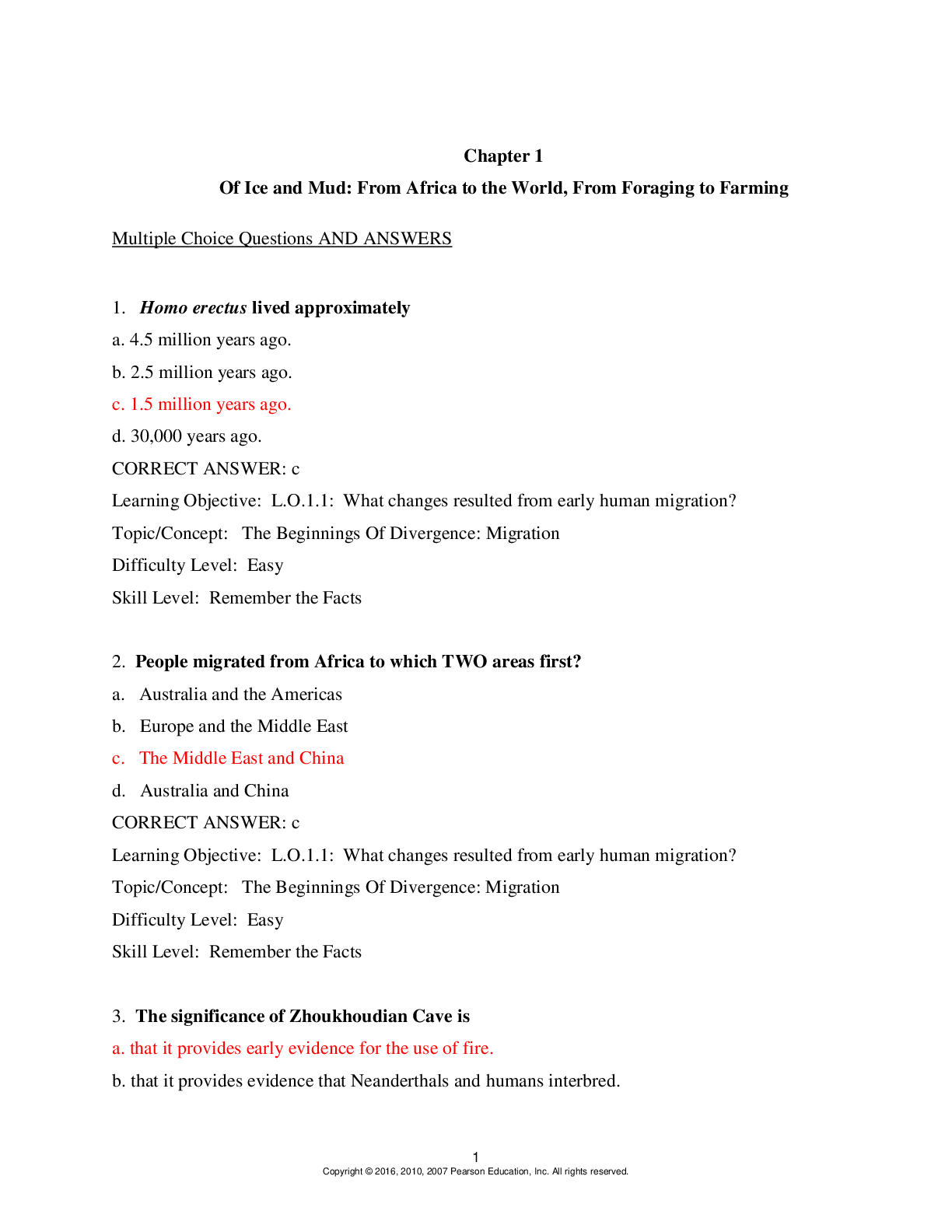
Reviews( 0 )
Document information
Connected school, study & course
About the document
Uploaded On
Nov 06, 2019
Number of pages
15
Written in
Additional information
This document has been written for:
Uploaded
Nov 06, 2019
Downloads
0
Views
99







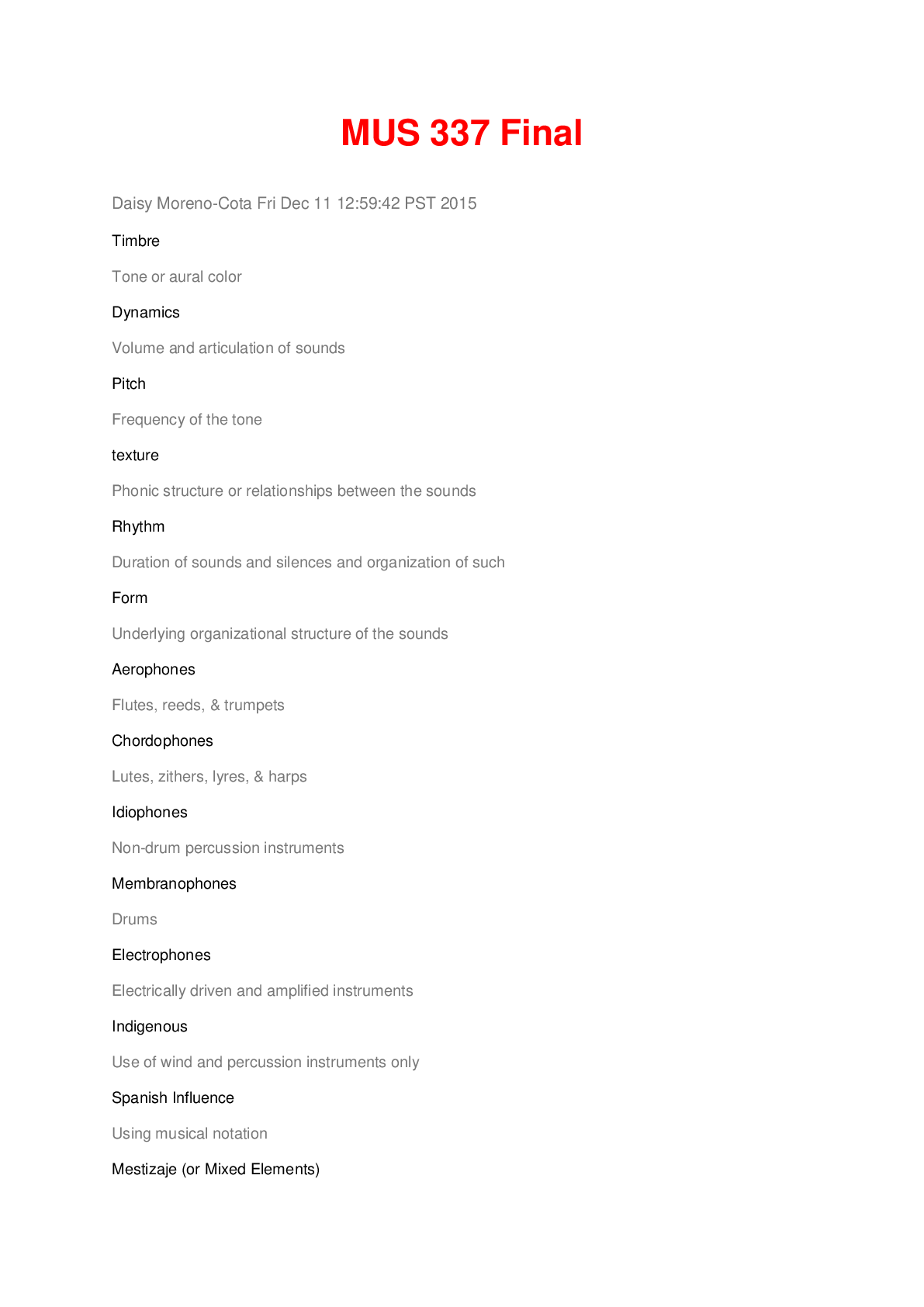







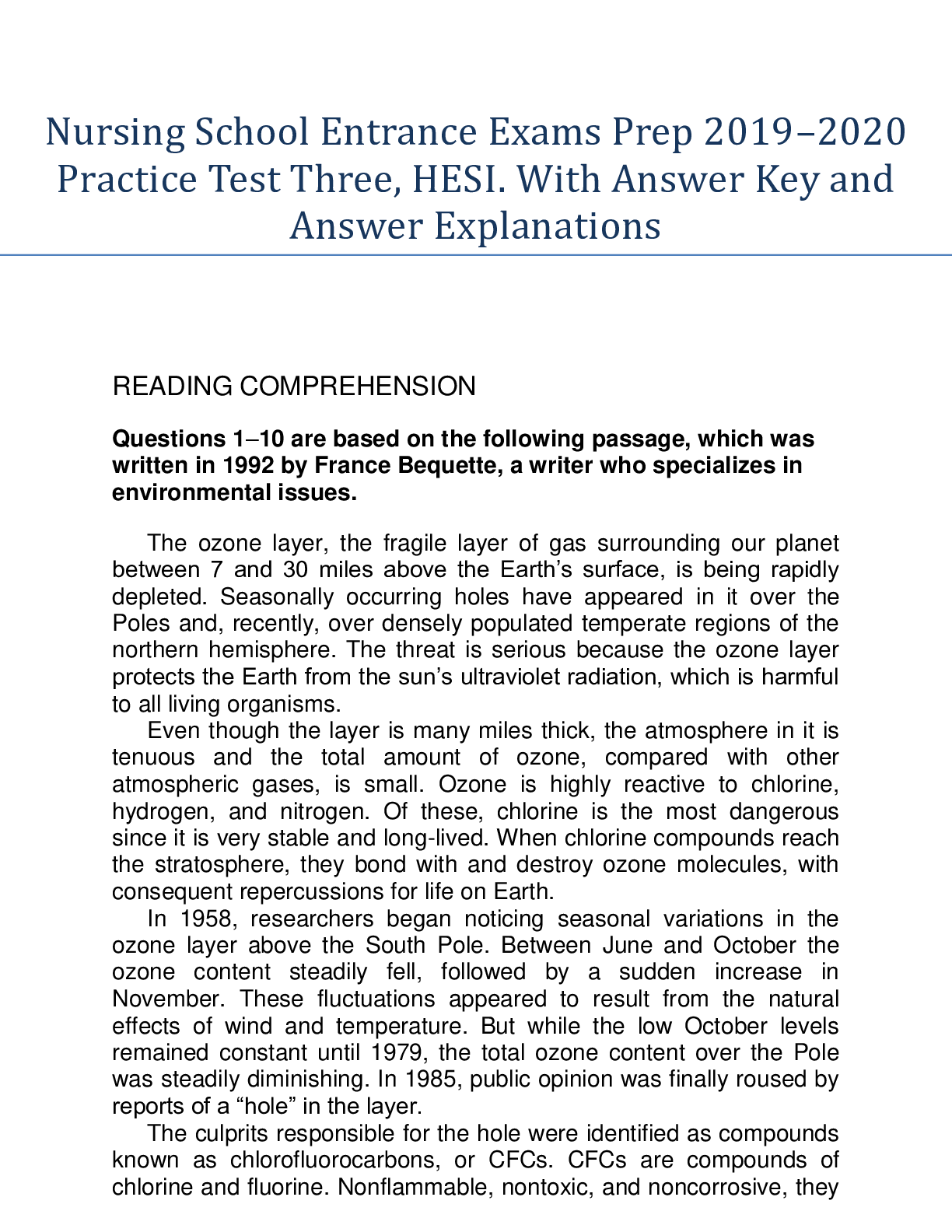


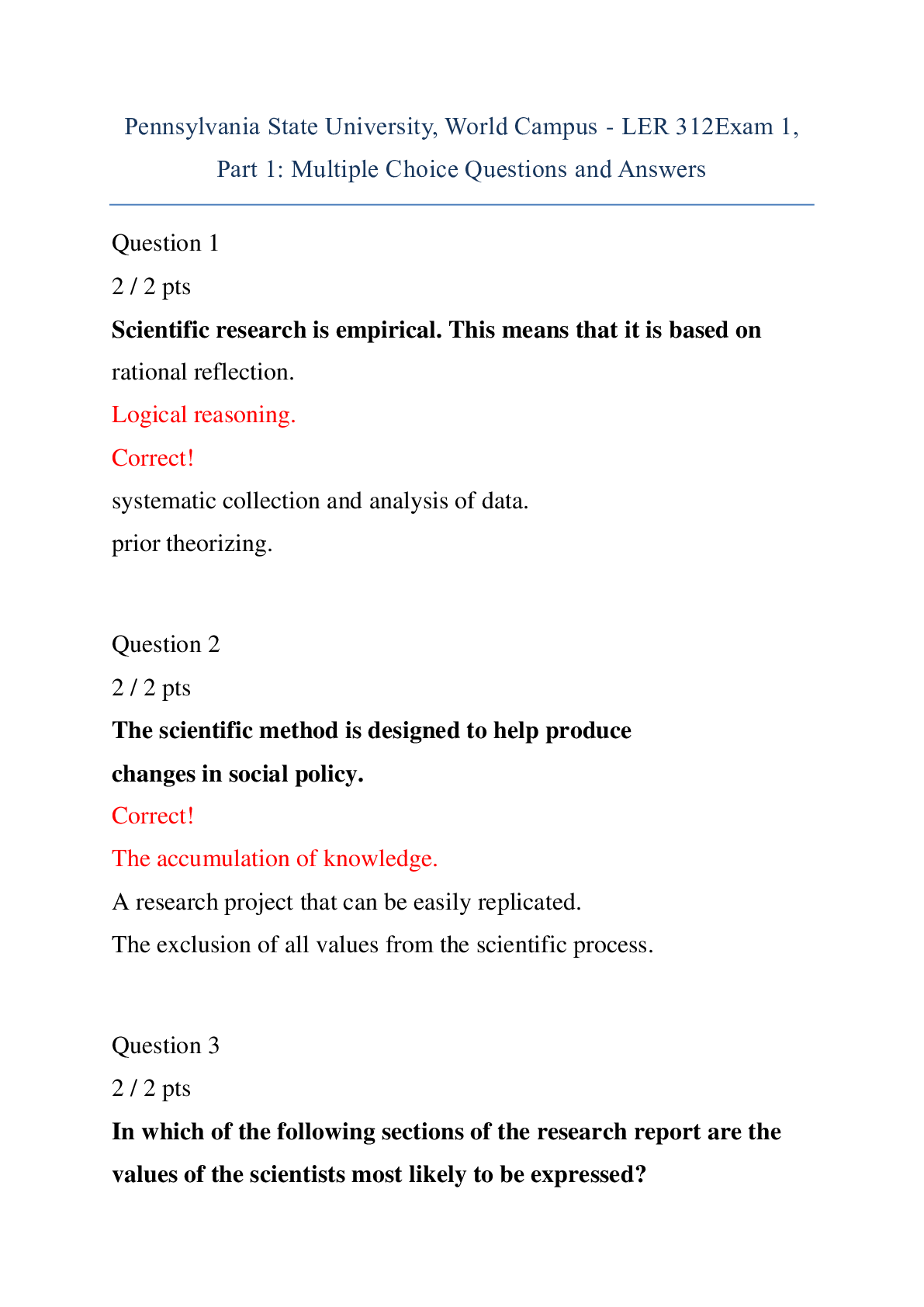


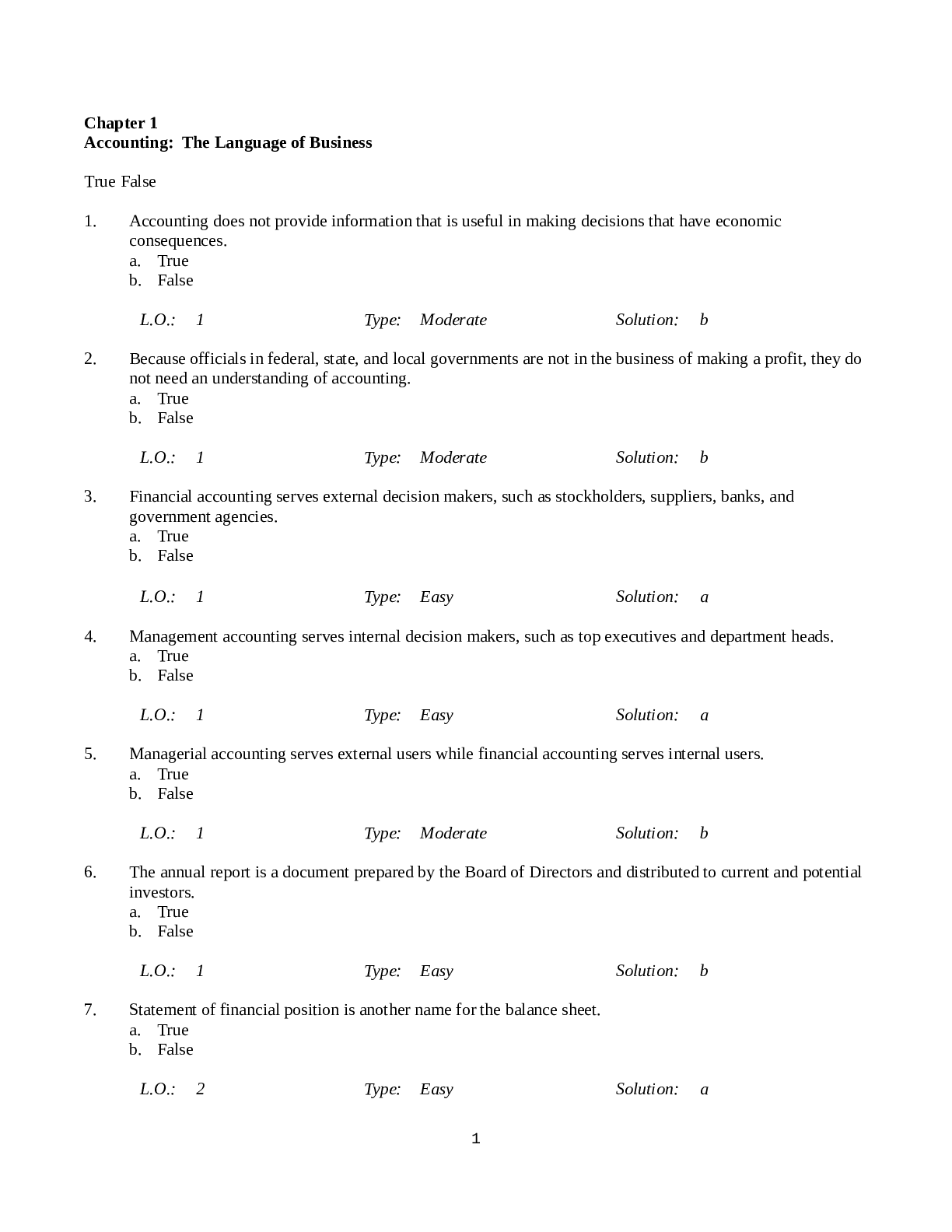

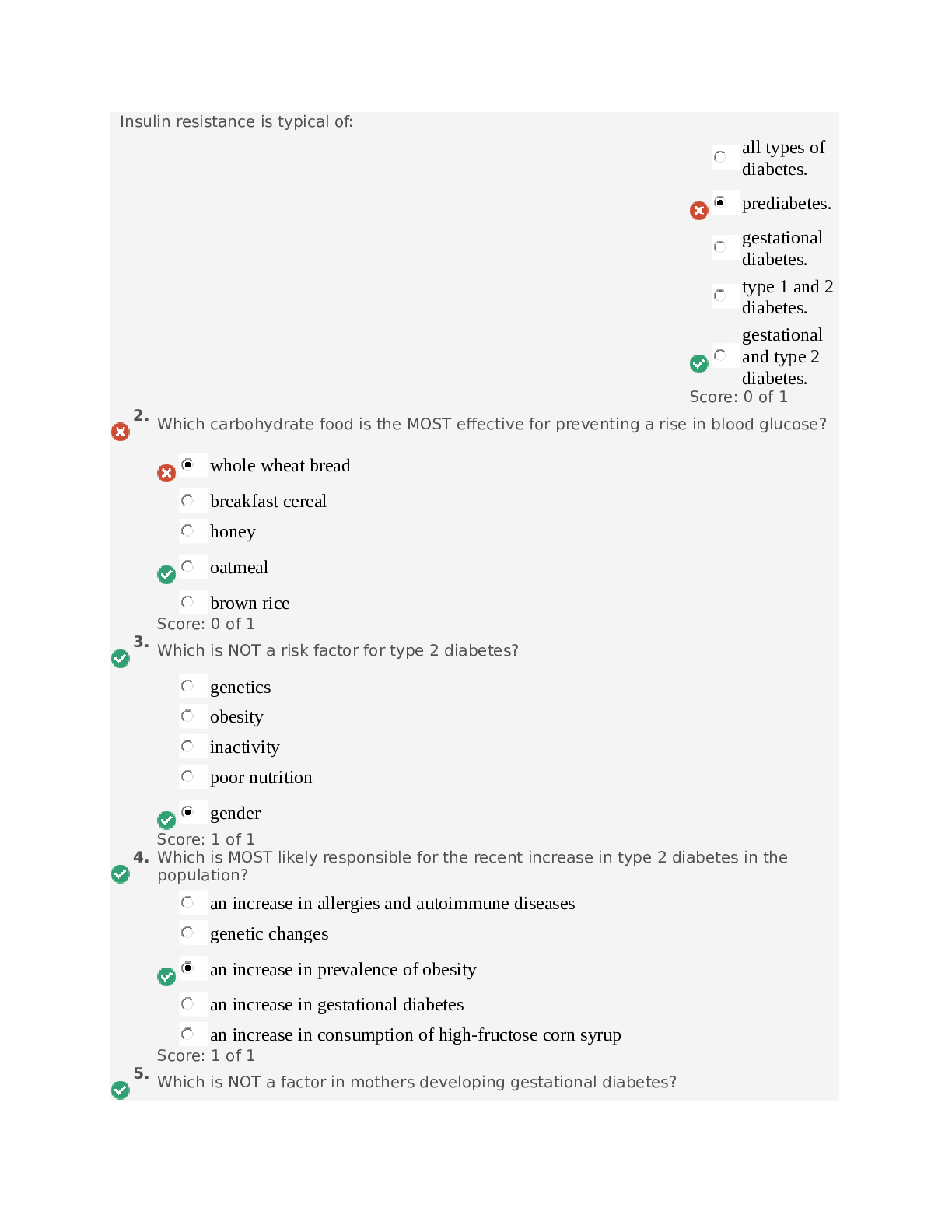
.png)
.png)
.png)
 Peter G.png)


 answers (1).png)

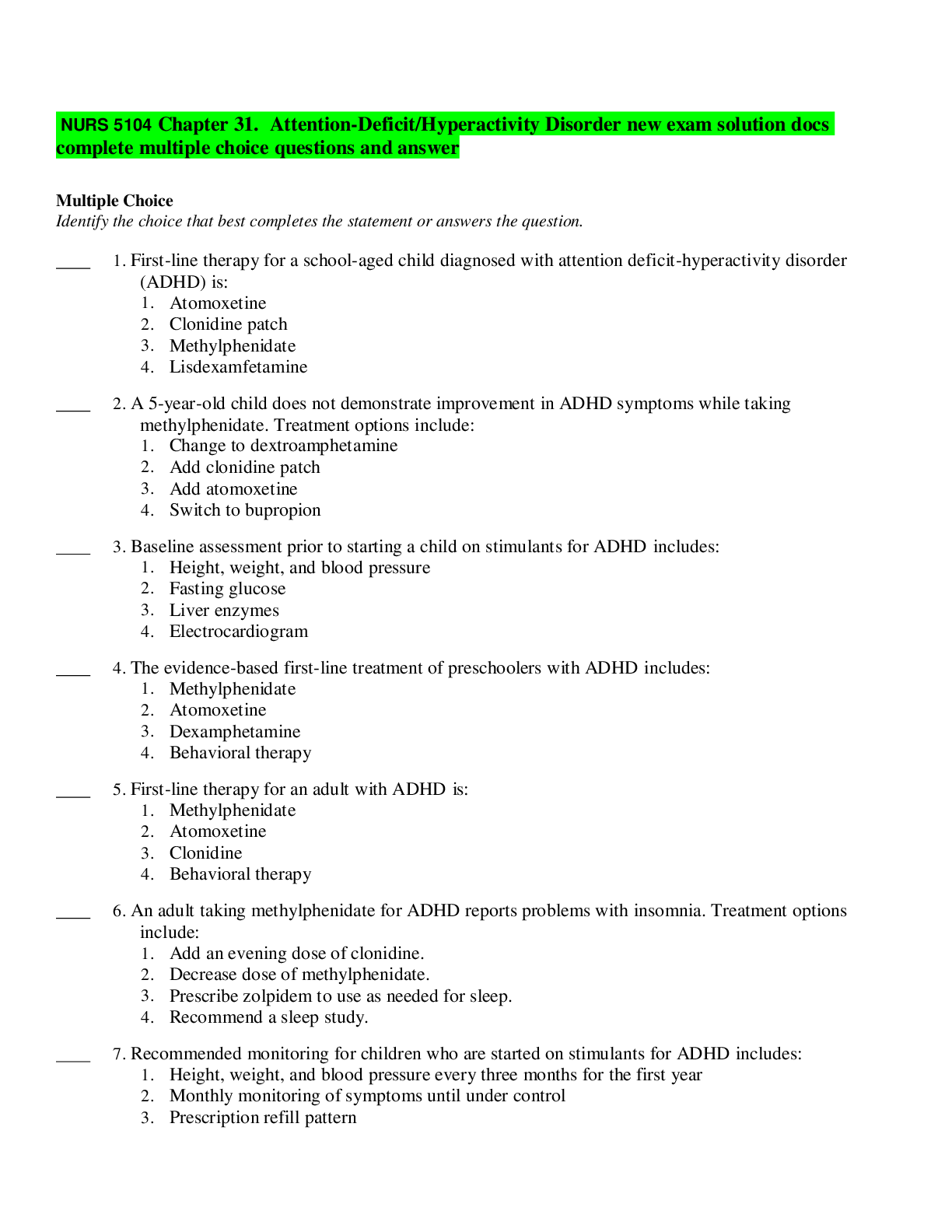

.png)
.png)

